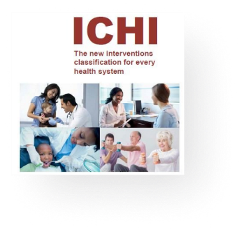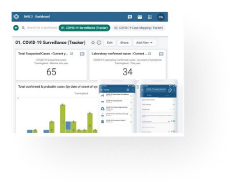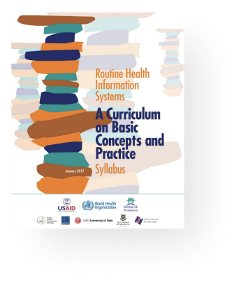
Optimize
health service data
Health service data are generated through several data subsystems including routine facility and community reporting systems; health facility surveys or accreditation systems for monitoring service availability, quality and effectiveness; and various health resource data systems such as health workforce information systems, health financing information system, and logistics management information systems (LMIS). Data need to be collected from all levels of facilities, including primary care facilities. Primary health care is critical for achieving UHC and primary care facilities remain the most cost-effective ways to address comprehensive health needs close to people’s homes and communities.
Key elements
Routine facility and community reporting system with patient monitoring
All countries should be able to continuously monitor health service use and coverage, disease patterns, individual client care and health care resources; and to produce and use timely and reliable, individual-level and aggregate statistics from all health facility levels, including community outreach programmes.
Regular system to monitor service availability, quality and effectiveness
All countries have in place an independent, objective, comprehensive system of external review, through health facility surveys or accreditation systems, to regularly monitor health service availability, readiness, quality and effectiveness.
Health service resources: finance and health workforce data
All countries systematically measure the flow of funds in their health system using a system of national health accounts, based on international standards. An electronic system for tracking public expenses at all levels of government is desirable to enable tracking of subnational health expenditures.
All countries have a system of national health workforce accounts (NHWA) that can generate and improve the availability, quality and use of health workforce data (including health workforce distribution).
Routine facility reporting system with patient and community monitoring

International Classification of Health Interventions (ICHI)
ICHI is the companion classification to the International Classification of Diseases (ICD) and the International Classification of Functioning, Disability and Health (ICF). The classification provides Member States, service providers, managers, and researchers with a common tool for reporting and analyzing health interventions including rehabilitation, allied health, mental health, nursing and public health interventions. ICHI contains more than 7,000 interventions to describe what health systems do. Further detail such as medical or assistive products can be added using extension codes.
Publishers
WHO
Year
2019

ICHI Training Course
The ICHI Training course aims to build basic understanding of the capacities in the application of ICHI classification for coding and reporting health interventions. The learning objectives are focused on the structure of the classification and statistical coding according to ICHI criteria.
Publishers
WHO
Year
2020

ICD-fit coding training and self-evaluation tool – Morbidity module
The ICD Field Implementation Tool (ICD-FIT) is a web-based coding training and self-evaluation tool for ICD-11. In the morbidity module, users practice using pre-coded code term sets extracted from cause of death certificates using the embedded ICD-11 coding tool. After completing the coding of a given term set, users get immediate feedback on their coding accuracy. The user’s code assignment for a given diagnostic term is compared with the gold standard and a summary score of the users coding performance is computed. The tool also provides a ranking of overall coding performance by users and measures the time spend by users when making the code assignment for each term.
Publishers
WHO
Year
2019

Analysis and use of health facility data
Based on WHO-recommended service delivery and programmatic standards, this toolkit comprises a set of resources to optimize the collection, analysis and use of data gathered through routine health facility information systems, also known as health management information systems (HMIS). The current and forthcoming standards include key disease and programme areas such as immunization, malaria, HIV, TB, reproductive, maternal, newborn, child, and adolescent health (RMNCAH), hepatitis B, neglected tropical diseases (NTDs), and noncommunicable diseases.
Publishers
WHO and University of Oslo
Year
2019

Master Facility List Resource Package
The MFL resource package guides countries through the process of establishing or strengthening a complete, up-to-date authoritative listing of their health facilities. The package includes case studies from various countries, and links to tools and practical resources that will be helpful to the implementation team as well as training resources. The package harmonizes multiple efforts to provide guidance to countries and was developed through a multi-partner initiative led by the DHS Program and WHO, with financial support from USAID and PEPFAR.
Publishers
DHS Program/WHO/USAID/PEPFAR
Year
2019

WHO Health App for DHIS 2
Parallel, disease-specific reporting systems are increasingly being integrated into a single platform at country level (e.g., DHIS 2). As part of the toolkit on analysis and use of health facility data, the WHO health app for DHIS 2 incorporates globally recommended health standards, including core indicators; data quality metrics and methods; cross-cutting and programme-specific analytical outputs; dashboards; and reports and data collection forms. The WHO health app incorporates standards for key programmes such as immunization, HIV, TB, malaria, RMNCAH and continues to incorporate others. It also includes the Startup Mortality List (SMoL) to simplify the recording of cause-of-death information using a list of most common causes from ICD-10, DQR metrics and analytics.
Publishers
WHO/University of Oslo
Year
2019 (for some programmatic areas)

DHIS2 – a Digital Tool for WHO RHIS standards
DHIS2 is an open source, web-based software platform for health data collection, management, and analysis. To date, DHIS2 is the world’s largest Health Information Management System (HMIS) platform in use by ministries of health in 72 low and middle-income countries, including national-scale deployments in 58 countries. With the capacity of collecting and reporting both individual and aggregate data from health facilities which feed in the national RHIS/HMIS integrated platform, the system enables analysis and use for health information management at national and sub-national levels
Publishers
WHO/University of Oslo
Year
2020

RHIS Rapid Assessment Tool
This tool helps health information system (HIS) managers and evaluators to address gaps and weaknesses in the RHIS by comparing a country’s RHIS to global standards and identifying where resources should be invested to improve the system.
A rapid assessment can be conducted by bringing together representatives from different levels of the health system and different programme areas into a workshop setting to determine the extent to which the RHIS adheres to standards, or by emailing the assessment to RHIS stakeholders and compiling their responses. A more in-depth assessment of adherence to health information standards can be made through site visits and sample interviews with staff in RHIS sub-national management units and health facilities.
The tool includes an implementation guide, data entry module and an analysis and dashboard module.
Publishers
MEASURE/JSI/USAID/WHO/Data for Health
Year
2018

Performance of Routine Information System Management (PRISM)
The Performance of Routine Information System Management (PRISM) framework consists of tools to assess RHIS) performance, identify technical, behavioural and organizational factors that affect RHIS, help design priority interventions to improve performance, and improve quality and use of routine health data. Initiated in 2011, the PRISM approach has been used in many low- and middle-income settings in order to assess the reliability and timeliness of an RHIS for making evidence-based decisions and identify and address RHIS gaps. The toolkit has been revised to create a broad array of materials: the “PRISM Series.”
Publishers
ME/USAID
Year
2018

Routine Health Information Systems: A curriculum on basic concepts and practice
This curriculum (including a syllabus, facilitator’s guide, and modules) provides training to help low- and middle-income countries meet the challenge of strengthening their routine health information system (RHIS). Its purpose is to enhance participants’ capacity to conceptualize, design, develop, govern, and manage an RHIS—and use the information the system generates to improve public health practice and service delivery.
The curriculum was jointly developed by MEASURE Evaluation (funded by USAID) and WHO in collaboration with experts at the universities of Brussels, Oslo, and Queensland; the Instituto Nacional de Salud Pública, Mexico City; the Public Health Foundation of India, New Delhi; and the Agence Européenne pour le Développement et la Santé, Brussels.
Internal Resources
Publishers
USAID/Measure Evaluation/WHO
Year
2017
Regular system of monitoring service availability, quality and effectiveness

Standardized Health Facility Survey Modules
In order to provide a comprehensive assessment of the functioning of a health system and its impact on health, data from health facilities are needed. Routine facility reporting systems provide key information for monitoring and evaluation of service use and resource availability. Health facility surveys periodically collect information from health facilities that are not included in routine reports and can provide a holistic picture of how inputs, processes and systems come together at a service site to influence outputs and outcomes. They provide external validation to self-reports and are an efficient way to collect information complementary to routine reporting that is needed for monitoring service quality and identifying where change is needed to strengthen the health system.
Over the years, a number of international health facility assessment tools (e.g. SARA, SPA, SDI) have been designed and used for measuring health system capacity to provide quality services. These surveys either collected much of the same information in different ways making it difficult to standardize and compare information; were implemented in an uncoordinated fashion, leading to inefficiencies in the use of resources; or were focused on only a specific aspect of facility care such as quality of care in a specific service area, for e.g. newborn care or HIV care.
To address this, WHO and partners examined key information collected in the different surveys, looked at emerging health programme needs and developed a harmonized set of key indicators and topics and standard questions (core and extended) to measure them. In addition, as changes in the different key topics follow different timelines, these modules can be implemented at different periodicities based on country need and context.
Publishers
WHO
Year
2020

Service Availability and Readiness Assessment (SARA)
The Service Availability and Readiness Assessment (SARA) was developed by WHO and USAID to fill critical gaps in measuring and tracking progress in health systems strengthening. As a health facility assessment tool, it is designed to assess and monitor service availability and readiness, and to generate evidence to support ongoing planning and management. The objective of SARA is to generate reliable and regular information on service delivery (such as the availability of key human and infrastructure resources); on the availability of basic equipment, basic amenities, essential medicines, and diagnostic capacities; and on the readiness of health facilities to provide basic health-care interventions relating to family planning, child health services, basic and comprehensive emergency obstetric care, HIV, TB, malaria, and noncommunicable diseases. The service availability and service readiness sections of the standardized health facility survey tool are the same as the SARA
Internal Resources
Publishers
WHO
Year
2015

Service Provision Assessment (SPA) Survey
The Service Provision Assessment (SPA) survey is a health facility assessment that provides a comprehensive overview of a country’s health service delivery. SPA looks at availability of health services; the extent to which facilities are ready to provide health services (do they have the necessary infrastructure, resources and support systems?); the extent to which service delivery processes meet accepted standards and quality of care; and if clients and providers are satisfied with the service delivery environment.
Publishers
USAID
Year
2012

Service Delivery Indicators (SDI)
The Service Delivery Indicators (SDI) survey collects actionable data on service delivery in schools and health facilities. The SDI data are used to assess the quality and performance of health services so that decision-makers can track progress over time, and so that citizens can hold governments accountable for public spending. The SDI initiative is a partnership of the World Bank, the African Economic Research Consortium, and the African Development Bank.
Publishers
World Bank
Year
2012

Health Resources Availability Monitoring System
HeRAMS is an approach for monitoring health facilities, services, and resource availability in emergencies. It is designed to provide timely identification of needs and gaps in order to underpin evidence-based decision-making and coordination, efficient planning and implementation, response monitoring, and advocacy and resource mobilization. HeRAMS can be applied in a range of emergencies, post-emergencies, recovery and development contexts. The HeRAMS App provides a monitoring feature that can track the evolution of the situation over time and help re-adjust objectives and priorities as the situation evolves. It is supported by an online application (https://primewho.org/) that maximizes data entry and data management processes and provides real-time analysis of the situation.
Publishers
WHO
Year
2016

Guidance on designing healthcare external evaluation programmes, including accreditation
External evaluation programmes, which include accreditation, certification and licensing of health care institutions, are among measures that can help improve organizational efficiency and effectiveness as well as the safety and quality of services. The purpose of this document is to guide countries, agencies, and other groups in setting up new health or social care external evaluation organizations or programmes. It is also intended to help funding and development agencies such as the World Bank, international aid and technical cooperation agencies, WHO, ministries of health and other government agencies, groups and organizations that want to improve the quality and safety of health care in their country, region or specialized area of health.
In addition to setting up accreditation programmes this document also addresses how to set up other external programmes such as certification and licensing which have different scopes and organisational coverage but are based on the same principle – evaluating and improving performance against a defined set of standards or criteria and using external evaluators to improve the safety and quality of health services for the public.
Publishers
ISQua
Year
2015
Health service resources: finance and health workforce data

A System of Health Accounts (2017 revised addition)
The System of Health Accounts - SHA 2011 - is a statistical reference manual giving a comprehensive description of the financial flows in health care. It provides a set of revised classifications of health care functions, providers of health care goods and services and financing schemes. The SHA is currently used as a basis for a joint data collection by OECD, Eurostat and WHO on health care expenditure. The SHA classifications build on common concepts, boundaries, definitions and accounting rules for measuring consumption of health care goods and services. The use of SHA clearly enhances the coherence and comparability of health care expenditure statistics over time and between countries.
Included with the reference manual are a health accounts production tool (HAPT) and health accounts analysis tool (HAAT). The HAPT provides step-by-step directions to guide country teams through the health accounts production and estimation process. The HAAT guides health accounts teams through the analysis of health expenditure data by automatically producing relevant graphs and charts using data entered into the production tool.
Internal Resources
Publishers
OECD/Eurostat/WHO
Year
2017

National Health Workforce Accounts (NHWA): a handbook
National Health Workforce Accounts (NHWA) is a system by which countries progressively improve the availability, quality, and use of data on their health workforce through monitoring of a set of indicators to support achievement of UHC, the SDGs and other health objectives. The purpose of NHWA is to facilitate the standardization of a health workforce information system for interoperability, as well as to support tracking human resources for health (HRH) policy performance towards UHC.
Key supporting resources developed to guide the production of health workforce accounts for countries include:
- NHWA Handbook.
- NHWA Implementation Guide – to help countries sustainably implement NHWA manner.
- Web platform to store data, monitor their indicators and report key national statistics on their health workforce.
- NHWA Online Data Platform – enables countries to record, analyse and visualize health workforce (HWF) information primarily for their own use.
- NHWA Web Portal – developed to display aggregated data validated by countries. This publicly available portal serves as a global public good for dissemination of globally harmonized health workforce data.
Publishers
WHO
Year
2017

International Standard Classifications of Occupations (ISCO-08)
ISCO is a tool for organizing jobs into a clearly defined set of groups according to the tasks and duties the job entails. Its main aims are to provide a basis for the international reporting, comparison and exchange of statistical and administrative data about occupations; a model for the development of national and regional classifications of occupations; and a system that can be used directly in countries that have not developed their own national classifications.
Publishers
ILO
Year
2011
